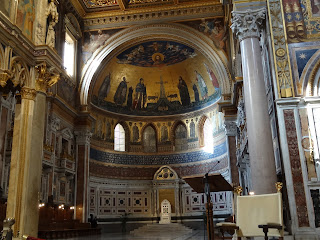Saints Francis and Clare are the two most famous saints of the hillside town of Assisi.
 |
| Image of Clare on a wall by San Damiano |
The presence of Saint Francis is tangible in Assisi. Almost
everywhere you turn there are images of the beloved Poverello, the Poor Man of
Assisi. You can see Franciscans walking in the streets and praying in the
numerous churches connected with Francis.
Though Clare lived in Assisi for more years than Francis you
have to look for signs of her presence.
 |
| The basilica and convent of St. Clare, Assisi |
The most obvious is the Basilica of Santa Chiara, which not
only houses her tomb but also the crucifix that hung in San Damiano. Before
that crucifix Francis sensed God calling him, “Rebuild my church, which, as you
see, is falling into ruins.”
San Damiano was the first home of the religious community
gathered around Clare. There she lived and died, strongly holding on to the
call to poverty and non-possession that she got from Francis.
 |
| San Damiano |
The sisters later moved up to the convent by the basilica
and took the crucifix with them.
There I experienced a deep renewal of my call to mission. I
asked the Crucified Lord, “What am I to do?” In my heart I heard a threefold
call: Love. Love my people. Love the
poor.
There I prayed as the sisters sang Vespers one night. There
I spoke haltingly in a mix of Italian and Spanish with a sister who gave me a
pile of holy cards for the poor of the parish where I work here in Honduras.
The place is holy.
 |
| San Rufino Cathedral, Assisi |
Another day I visited the cathedral of San Rufino where
Francis and Clare were both baptized. I think Clare family lived near the
cathedral and there is a little chapel there. But what is most delightful is
the plaque of Clare by the right entrance to the church.
There are other images of Clare in Assisi.
But the witness of the Poor Clares is the most important
sign of her presence – and her contemplative love of the Lord.
 |
| Fresco of Clare on a wall in Assisi |
Thus, one of my fondest memories of Assisi is Vespers in the
church of San Quirino. The last evening I was in Assisi I went to this very
simple, unadorned church connected with a convent of Poor Clares.
 |
| Clare on the grounds of the Porziuncula |
About twelve sisters were seated in the sanctuary and
another old man and I were the only others present.
As Vespers began with a hymn, Adoro te, devote, one of the sisters brought a small monstrance
with the Host to the altar.
Vespers was sung simply, accompanied by a string instrument
(like a dulcimer).
It was a place of peace, a place where God’s presence was
almost tangible.
It was, for me, a thin place, reminding me to be open to the presence of Christ in the little things - from the defenseless Eucharist on an altar in Assisi to the poor people at the margins of society, the lesser brothers and sisters with whom Francis and Clare sought to identify.
Clare, clear light of God's loving presence, pray for us.












